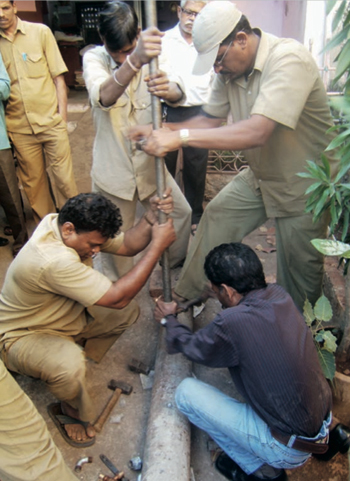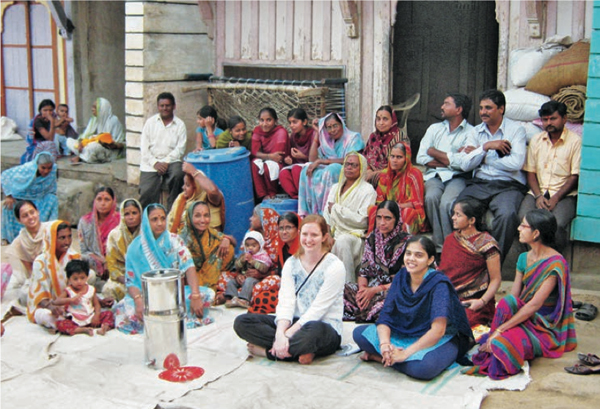
Taking MIT’s “Mens et Manus” (Mind and Hand) motto to heart, the new Tata Center for Technology and Design is pioneering a multidisciplinary approach to problem solving in the context of developing countries. “We are giving our students a unique opportunity to immerse themselves in settings where societal needs and aspirations are no different from anywhere else, but where poverty and limited access to technical capacity, materials, and energy, for example, create an unfamiliar and very challenging solution space for engineers and entrepreneurs,” says Robert Stoner, the program’s co-director and MIT Energy Initiative (MITEI) associate director.
Launched in April 2012 and headquartered at MITEI, the center was funded by a gift from the Sir Dorabji Tata Trust to pursue a unique educational mission. The center selects incoming master’s degree students from a wide range of MIT departments to become Tata Fellows. Working closely with the program directors and their departmental advisors, fellows will travel extensively to India over the course of their two years of study, pursuing thesis projects that respond to rural and urban needs throughout India. Each student must identify a challenge and propose a practical design solution shaped by technical requirements as well as business, economic, and social considerations.

At a paper mill in Muzaffarnagar, Uttar Pradesh, India, Tata Fellow Bhushan Desam of the System Design and Management program examines waste plastic mixed in with recycled magazines, books, and cartons. This material is currently burned directly as fuel, creating significant environmental pollution. Desam’s project aims to convert the plastic instead into valuable products such as fuel oil. Photo: Bhushan Desam G, MIT
The ambitious program, which so far includes projects focused on energy, water, healthcare, agriculture, and housing, calls on students to be simultaneously creative, pragmatic, and entrepreneurial. It has proven an irresistible opportunity for some. “I wanted to do something for India, apply what I was learning, and contribute to solving a major social problem,” says Bhushan Desam, whose master’s and PhD research at the University of Utah concerned water treatment and combustion-generated pollution. Desam learned about the new Tata Center after arriving at MIT to pursue a master’s degree in system design and management. A native of India, he leaped at the chance to apply “because I thought I might be able to contribute my expertise to help solve some of the many energy and environmental challenges there.”
Desam traveled to India with other members of the inaugural class of 17 Tata Fellows. “Our faculty said talk to people, see the needs, and find a project,” he recounts. Led by MIT Sloan Professor Charles Fine, the other Tata Center co-director, Desam’s group investigated possibilities in Muzaffarnagar, which is home to sugar refineries, paper mills, and rice processing plants that discharge their waste products into rivers or burn them, polluting the environment. Local industry leaders, deeply worried about these environmental toxins, told the Tata team that they keenly sought affordable technologies for controlling this pollution.
Tata projects require close collaboration with local partners, and Desam found a paper mill owner with a specific problem: “This man has a lot of plastic mixed into his recycled paper. He wanted to find some way of using the plastic and helping the environment,” says Desam, “but he couldn’t do his own R&D.” Desam’s research resulted in a business prospect enthusiastically embraced by the paper mill owner: the idea of burning locally abundant sugar cane waste, a carbon-neutral fuel, to power the conversion of recycled plastics into valuable diesel oil. “I’m looking at the kind of technology we should implement, and the economics of the situation, to come up with a solution that makes some money and cleans up the environment, too,” Desam says.

In urban centers in India, some people connect suction pumps directly to the water system to siphon water out of the network—a practice that reduces system-wide pressure and can even pull sewage into the water mains. Tata Fellow David Taylor of mechanical engineering is developing a robust, purely mechanical device that will stop personal pumps from siphoning off water but not interfere with their ability to increase water pressure within a home. Here, Taylor watches a Mumbai repair crew install a new pipe fitting—without using any power tools. Photo: David Taylor G, MIT
The solutions that Tata Fellows work on “may span several generations of students,” says Fine. Successive teams might lead the discovery and problem formulation stages, conceptual design, prototyping, and testing in labs and in the actual environment. But all aspects of these projects require proximity to native stakeholders. “We need to know if our solutions are culturally appropriate and fit the lives of the people who will use them,” Fine says. “Our hope is to create a program and curriculum that delivers knowledge and an experience base to students—and delivers projects of real value to people with real needs and fewer resources than people in the US.”
Among other things, students find themselves confronted with daunting cost targets. To equip students to meet these targets, the program will build on some of the low-cost design concepts championed by Ratan N. Tata, former chairman of the Tata Group global conglomerate, whose motor company created the Nano, a technologically sophisticated, ultralow-cost passenger car for Indian consumers. A member of MITEI’s External Advisory Board, Tata engaged MIT to realize his vision: an educational program to produce a new generation of entrepreneurial engineers who can seize technological opportunities in the most resource-constrained settings.
A core group of MIT faculty is already deeply engaged in studying products in India and other developing economies that offer helpful clues. As Stoner points out, “We’re finding that it’s not about trying to make something cheap, but rather about making it less costly and at the same time better.” In India and other emerging nations, he says, “people want nice cars, houses, appliances, ovens, computers, medical care… It takes a considerable amount of ingenuity and market awareness to make something much less expensive but also pleasing, and of course, functional.” It will be incumbent on Tata Fellows seeking meaningful ventures “to look at all the barriers that prevent people from accessing modern lifestyles across a wide range of activities,” he says.

Natasha Wright (center front), Tata Fellow and graduate student in mechanical engineering, meets with women residents of a village in Maharashtra, India. The steel point-of-use filtration system (shown in photo) is commonly found in rural villages. Wright is studying existing water purification technologies in villages like this to determine what works well and what changes residents might like to see. Interviews with local residents helped to reveal the advantages and disadvantages of community-based versus point-of-use systems. Photo: Natasha Wright G, MIT
Initial project ideas range from self-contained electrical grids built on a village scale and low-cost food processing systems to affordable medical diagnostic and treatment technologies, including prosthetic limbs. For one venture, under the direction of Assistant Professor Amos Winter and the Global Engineering and Research Lab, Tata Fellow Natasha Wright has begun designing inexpensive, village-scale, solar-powered water purification systems. Teamed up with Jain Irrigation, an Indian company, she is devising technologies to eliminate not only unpalatable salts from the often highly saline groundwater but also the microbial and chemical contaminants that prove a hazard for villagers relying on wells or river water, especially during monsoon season.
Existing technology to remove these dangerous impurities may prove too expensive for families who earn just a few dollars a day. Maintenance brings additional costs, if parts and skilled labor are even available. Wright, a first-year mechanical engineering master’s student, must crack these problems, as well as the issue of cultural acceptance. “Some households prefer clay pots, called gharas, to keep their water cool, but these pots have a wide opening allowing for recontamination.” She intends to build and field test a cluster of adaptable solutions before completing her degree in 2014.
In spite of these formidable challenges, Wright says the project “is a perfect fit” for her. The fellowship drew her to MIT for graduate studies and, she concludes, “pursuing high-level research and applying it to a real-world product of global importance—that really speaks to me.”
Stoner, Fine, and their collaborators believe that this kind of passionate engagement will make a tangible impact on the world, and in a relatively short period of time. With between 20 and 30 new students joining the Tata Center each year, a broadening curriculum, and an increasingly knowledgeable and committed faculty team, they envision that by the end of five years, students will have completed more than 150 projects that touch all segments of Indian society, allowing many more people there to experience modern life as we experience it.
This article appears in the Spring 2013 issue of Energy Futures.